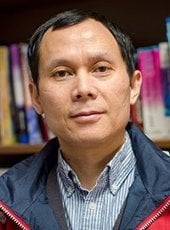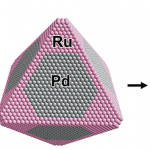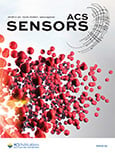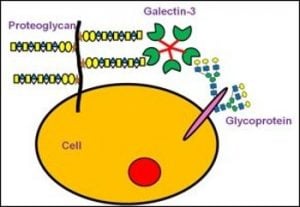Graduate student Gemechis Degaga (Chem) and Loredana Valenzano (Chem) have published the paper “Part I: C2-C4 Hydrocarbons Separation Addressed via Molecular Cluster Models Carved Out from Periodic MOF-74-Mg/Zn Structures” on Chemical Physics Letters. The paper can be found here.
 Science360, a science news website published by the National Science Foundation (NSF) featured the synthetic DNA research of Professor Shiyue Fang (Chem) as one of its “Headlines.”
Science360, a science news website published by the National Science Foundation (NSF) featured the synthetic DNA research of Professor Shiyue Fang (Chem) as one of its “Headlines.”
Tarun Dam led a new study, published this week in Biochemistry, examining the biomechanics of galectin-3’s interaction with glycosaminoglycans (GAG) and proteoglycans. His team includes graduate students Melanie Talaga, Ni Fan, Ashli Fueri, Robert Brown and Research Assistant Professor Purnima Bandyopadhyay.
At the Laboratory of Mechanistic Glycobiology, Dam and his students study the sugar, including glucose and other structural, complex sugars, that fuel our bodies. GAGs assist in controlling growth factor proteins, which go unchecked as cancerous tumors grow.
Even though the findings of the study were unexpected, it opens up new possibilities for understanding glycobiology and biomechanics. “Seeing galectin-3 interact with GAGs and proteoglycans is like finding a rose in the petunias—it’s very unexpected,” Dam says. “It’s fair to say that this requires revisiting the reported biological functions of GAGs, proteoglycans and galectin-3.”
Next, Dam and his team look into additional research, “Now we have to reconsider the whole drama, retracing the steps and actions of that character… we are using cell lines and animal models to study this interaction in a cellular context.”
Read more on Michigan Tech News, by Allison Mills.
 Deposition followed by etching yields ruthenium nanoframes
Deposition followed by etching yields ruthenium nanoframes
Michigan Technological University chemists Xiaohu Xia and Haihang Ye, together with researchers at the University of Texas, Dallas, and elsewhere used a ruthenium chloride solution to preferentially deposit ruthenium on the edges and corners of nanosized palladium octahedral seed crystals.
Read more at Chemical & Engineering News, by Mitch Jacoby.
A Noble Calling: Ruthenium Nanoframes Open the Doors to Better Catalysts
The world is run by catalysts. They clean up after cars, help make fertilizers, and could be the key to better hydrogen fuel. Now, a team of chemists, led by Xiaohu Xia from Michigan Technological University, has found a better way to make metal catalysts.
“We are fine-tuning the surface, size, shape and crystal structure,” he says. “Our goal is to increase their catalytic activity while reducing the usage of this precious material.”
 Graduate students Jingtuo Zhang, Mu Yang, Wafa Mazi, Mingxi Fang, Fei Xie, Postdoctoral Associate Kapil Adhikari, Assistant Professor Loredana Valenzano, Associate Professor Ashutosh Tiwari and full Professor Haiying Liu (all from the chemistry department) published a paper entitled, “Unusual Fluorescent Responses of Morpholine-Functionalized Fluorescent Probes to pH via Manipulation of BODIPY’s HOMO and LUMO Energy Orbitals for Intracellular pH Detection,” in ACS Sensors. This project is funded by NIH.
Graduate students Jingtuo Zhang, Mu Yang, Wafa Mazi, Mingxi Fang, Fei Xie, Postdoctoral Associate Kapil Adhikari, Assistant Professor Loredana Valenzano, Associate Professor Ashutosh Tiwari and full Professor Haiying Liu (all from the chemistry department) published a paper entitled, “Unusual Fluorescent Responses of Morpholine-Functionalized Fluorescent Probes to pH via Manipulation of BODIPY’s HOMO and LUMO Energy Orbitals for Intracellular pH Detection,” in ACS Sensors. This project is funded by NIH.
DOI: 10.1021/acssensors.5b00065

Lynn Mazzoleni (Chem), was recently awarded a Fulbright Scholar Award to study one of Europe’s pollution hot spots. Currently on sabbatical in Bologna, Italy, Mazzoleni is collaborating with researchers in the Institute of Atmospheric Sciences and Climate at the Italian National Research Council. Their study focuses on the chemistry of atmospheric nitrogen species to improve the understanding of aqueous phase chemistry that contributes to the high concentrations of aerosol pollution.
Dr. Donald Bergstrom
Professor Emeritus
Department of Medical Chemistry and Molecular Pharmacology,
Purdue University, West Lafayette, Indiana
Date: October 16, 2015
Place: Chem-Sci Room 101
Time: 3:00 pm
Abstract
For more than a half century I have designed and created new molecules. My research has been shaped within the contexts of culture, time, and place, at times responding to the work of others, but always attempting to ride the wave front of science. “At the End of Chemistry” follows the trajectory of my research from rocket design in the 1950’s to nanomaterials in the 21st century. It is both report and inquiry about the nature of research.
Biography
Don Bergstrom has held faculty positions at Purdue University (1989-2011), the University of North Dakota, and the University of California, Davis. He holds degrees in chemistry from the University of Washington (BS, 1965) and the University of California, Berkeley (PhD, 1970). From the early 1970s the work in his laboratory focused on nucleic acid chemistry, particularly the synthetic chemistry and applications of nucleosides. In the 21st century his efforts expanded into areas of nanotechnology and new approaches to drug design based on concepts of molecular self-assembly. He is currently a 2nd year graduate student in the MFA program in Applied Craft + Design at the Pacific Northwest College of Art.
Dr. Ayyalusamy Ramamoorthy, Professor
Biophysics and Department of Chemistry, University of Michigan
Date: September 25, 2015
Place: Chem-Sci Room 101
Time: 3:00 pm
Abstract
Membrane proteins are an exciting class of biomacromolecules and play important roles in a variety of biological processes that are directly linked to major diseases including cancer, aging-related diseases, and infectious diseases. A complete understanding of their function can only be accomplished using high-resolution structures and dynamics. In spite of recent developments in structural biology, membrane proteins continue to pose tremendous challenges to most biophysical techniques. A major area of research in my group is focused on the development of NMR techniques to study the dynamic structures of membrane bound proteins such as cytochrome b5, cytochrome P450 and cytochrome P450-reductase. In my talk, I will present strategies to study the structure and dynamics of these challenging systems and also on the electron transfer mechanism that enables the enzymatic function of P450. Atomic-level resolution NMR structures of amyloidogenic proteins revealing the misfolding pathway and early intermediates that play key roles in amyloid toxicity will also be presented.
References:
J. Biol. Chem. (2015) 290:12705-18; 290: 4843-55; 288:22080-95.
Chem. Soc. Rev. (2014) 43:6692-6700; J. Phys. Chem. Lett. (2014) 5:1864.
Biography
Dr. Ayyalusamy Ramamoorthy is Professor of Biophysics and Chemistry at University of Michigan, where he has been since 1996. He has applied NMR spectroscopy and other biophysical techniques to investigate high-resolution structure, dynamics, and functional properties of membrane proteins, amyloid proteins/peptides, and antimicrobial peptides. He has published more than 250 peer-reviewed papers in leading high impact journals like Science, PNAS, JACS, J. Biol. Chem., and Angew. Chem. Eng. Intl., written several review articles, edited 2 books on NMR spectroscopy, brought out several special issues as a guest editor, and organized several conferences related to NMR spectroscopy. He is a member of editorial boards of J. Biol. Chem., Plos One, Scientific Reports, Peer J, Biochimica Biophysica Acta, Journal of Magnetic Resonance, Chemistry and Physics of Lipids, Solid State Nuclear Magnetic Resonance Spectroscopy, and Magnetic Resonance in Chemistry. He has been a PI or co-PI on several NIH (and other) sponsored projects.
For more information visit http://rams.biop.lsa.umich.edu/
Dr. Xiaohu Xia
Assistant Professor
Department of Chemistry, Michigan Tech
September 18, 2015
Chem-Sci Room 101 3:00pm
Abstract
Peroxidase mimics (or artificial peroxidase) with dimensions at the nanoscale have received great interest as emerging artificial enzymes for biomedicine and environmental protection. While a variety of peroxidase mimics have been actively developed since 2007, limited progress has been made toward improving their catalytic efficiency. In our recent work (ACS Nano, 2015, in press, DOI: 10.1021/acsnano.5b03525), we reported a novel type of peroxidase mimic with record high efficiency. Our peroxidase mimic was engineered by depositing Ir atoms as ultrathin skins (a few atomic layers) on Pd nanocubes (i.e., Pd-Ir cubes). The Pd-Ir cubes exhibited significantly enhanced efficiency that is over 400-fold higher than that of natural peroxidase. In this talk, I will introduce the rational design, experimental synthesis, and mechanistic understanding of such a new peroxidase mimic. At the end, using human prostate specific antigen as a model example, I will highlight the application of our peroxidase mimic in ultrasensitive detection of disease biomarkers.
Jianheng Bi
Original Research Proposal
Michigan Technological University
Department of Chemistry
Advisor- Dr. Haiying Liu
Tuesday August 4, 2015
9:00 am
Chem-Sci 101
ABSTRACT
This proposal describes the preparation, characterization and application of gold nanorod-based theranostics for specific cancer imaging and therapy. Cancer theranostics will be constructed by modifying the gold nanorods with near-infrared dyes and cancer-imaging peptides via silica layers and poly(ethylene glycol) tethered spacers. The thickness of the silica layers will be carefully controlled to significantly enhance the fluorescence intensity of near-infrared dyes via a surface plasma of gold nanrods while specific targeting and imaging will be achieved through strong specific multivalent interactions of cancer-homing peptide residues with cancer cells and tissues. Once specific targeting to cancer cells or tissues are achieved, thermotherapy and photodynamic therapy will be conducted to kill cancer cells and tissues via thermal heat from gold nanorods and singlet oxygen generated by photodynamic agent under near-infrared pulse laser.
